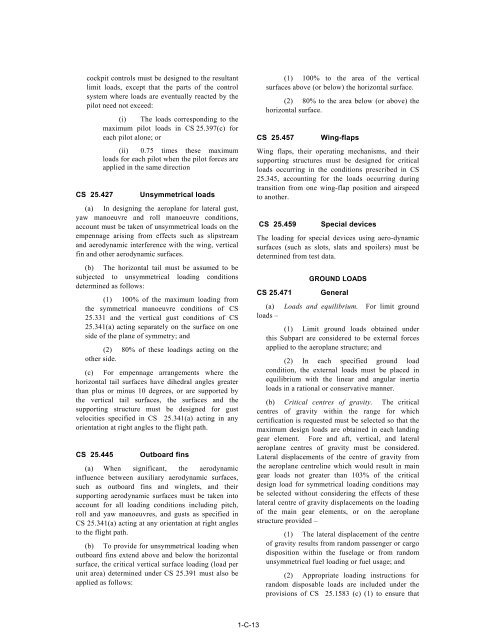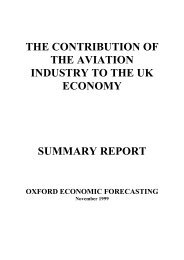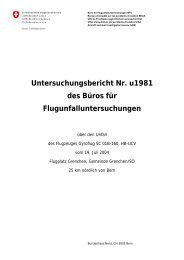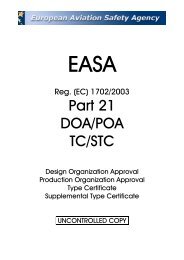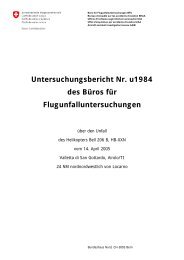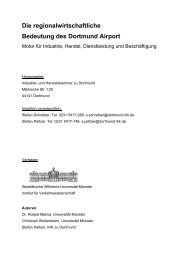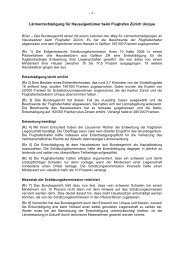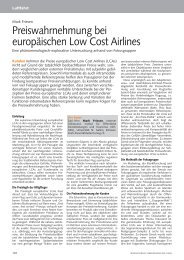- Page 1 and 2: European Aviation Safety Agency ED
- Page 3 and 4: European Aviation Safety Agency Cer
- Page 5 and 6: CS-25 INTENTIONALLY LEFT BLANK C-2
- Page 7 and 8: BOOK 1 CS-25 1-0-2
- Page 9 and 10: CS-25 BOOK 1 INTENTIONALLY LEFT BLA
- Page 11 and 12: CS-25 BOOK 1 (3) The highest weight
- Page 13 and 14: CS-25 BOOK 1 or 2%, whichever is gr
- Page 15 and 16: CS-25 BOOK 1 and the corresponding
- Page 17 and 18: CS-25 BOOK 1 (ii) 1·5% for three-e
- Page 19 and 20: CS-25 BOOK 1 (2) The weight equal t
- Page 21 and 22: CS-25 BOOK 1 CONFIGURATION SPEED MA
- Page 23 and 24: CS-25 BOOK 1 (c) V MC may not excee
- Page 25 and 26: CS-25 BOOK 1 CS 25.171 STABILITY Ge
- Page 27 and 28: CS-25 BOOK 1 CS 25.181 Dynamic stab
- Page 29 and 30: CS-25 BOOK 1 greater, except that i
- Page 31 and 32: CS-25 BOOK 1 INTENTIONALLY LEFT BLA
- Page 33 and 34: CS -25 BOOK 1 appropriate to each p
- Page 35 and 36: CS -25 BOOK 1 (b) Manoeuvring envel
- Page 37 and 38: CS -25 BOOK 1 (1) May not be less t
- Page 39 and 40: CS -25 BOOK 1 angular acceleration
- Page 41 and 42: CS -25 BOOK 1 (2) At speeds between
- Page 43: CS -25 BOOK 1 flight load condition
- Page 47 and 48: CS -25 BOOK 1 may be considered. Th
- Page 49 and 50: CS -25 BOOK 1 (b) For towing points
- Page 51 and 52: CS -25 BOOK 1 CS 25.561 Emergency L
- Page 53 and 54: CS -25 BOOK 1 determination must be
- Page 55 and 56: CS -25 BOOK 1 INTENTIONALLY LEFT BL
- Page 57 and 58: CS-25 BOOK 1 (1) Where applied load
- Page 59 and 60: CS-25 BOOK 1 CS 25.631 (vi) Any sin
- Page 61 and 62: CS-25 BOOK 1 (2) Each fitting, pull
- Page 63 and 64: CS-25 BOOK 1 CS 25.721 LANDING GEAR
- Page 65 and 66: CS-25 BOOK 1 (1) The static ground
- Page 67 and 68: CS-25 BOOK 1 extension or after ret
- Page 69 and 70: CS-25 BOOK 1 inches) in height, is
- Page 71 and 72: CS-25 BOOK 1 (i) If an integral sta
- Page 73 and 74: CS-25 BOOK 1 (b) Signs that notify
- Page 75 and 76: CS-25 BOOK 1 Passenger seating conf
- Page 77 and 78: CS-25 BOOK 1 emergency exit which i
- Page 79 and 80: CS-25 BOOK 1 (1) For aeroplanes tha
- Page 81 and 82: CS-25 BOOK 1 affords a more effecti
- Page 83 and 84: CS-25 BOOK 1 (f) Means to enable th
- Page 85 and 86: CS-25 BOOK 1 (ii) No discharge of t
- Page 87 and 88: CS-25 BOOK 1 For compartments of 14
- Page 89 and 90: CS-25 BOOK 1 CS 25.865 Fire protect
- Page 91 and 92: CS-25 BOOK 1 INTENTIONALLY LEFT BLA
- Page 93 and 94: CS-25 BOOK 1 CS 25.904 Automatic Ta
- Page 95 and 96:
CS-25 BOOK 1 CS 25.945 Thrust or po
- Page 97 and 98:
CS-25 BOOK 1 structural loads that
- Page 99 and 100:
CS-25 BOOK 1 (d) Each fuel filling
- Page 101 and 102:
CS-25 BOOK 1 (b) Each drain require
- Page 103 and 104:
CS-25 BOOK 1 impaired when the oil
- Page 105 and 106:
CS-25 BOOK 1 (i) Under the icing co
- Page 107 and 108:
CS-25 BOOK 1 CS 25.1155 Reverse thr
- Page 109 and 110:
CS-25 BOOK 1 CS 25.1185 Flammable f
- Page 111 and 112:
CS-25 BOOK 1 so that discharge of t
- Page 113 and 114:
CS-25 BOOK 1 (8) An augmentation li
- Page 115 and 116:
CS-25 BOOK 1 (b) For functions whos
- Page 117 and 118:
CS-25 BOOK 1 (d) Each pressure alti
- Page 119 and 120:
CS-25 BOOK 1 quantity, in litres, (
- Page 121 and 122:
CS-25 BOOK 1 CS 25.1357 Circuit pro
- Page 123 and 124:
CS-25 BOOK 1 30º with a vertical l
- Page 125 and 126:
CS-25 BOOK 1 Angle above or below t
- Page 127 and 128:
CS-25 BOOK 1 (c) Radio and electron
- Page 129 and 130:
CS-25 BOOK 1 between which relative
- Page 131 and 132:
CS-25 BOOK 1 (2) A common source of
- Page 133 and 134:
CS-25 BOOK 1 interphone, public add
- Page 135 and 136:
CS-25 BOOK 1 INTENTIONALLY LEFT BLA
- Page 137 and 138:
CS-25 BOOK 1 CS 25.1519 Weight, cen
- Page 139 and 140:
CS-25 BOOK 1 (d) Each engine or pro
- Page 141 and 142:
CS-25 BOOK 1 (e) Kinds of operation
- Page 143 and 144:
CS-25 BOOK 1 INTENTIONALLY LEFT BLA
- Page 145 and 146:
CS-25 BOOK 1 CS 25A943 Negative acc
- Page 147 and 148:
CS-25 BOOK 1 CS 25A1045 Cooling tes
- Page 149 and 150:
CS-25 BOOK 1 APU FIRE PROTECTION CS
- Page 151 and 152:
CS-25 BOOK 1 (2) Have thermal stabi
- Page 153 and 154:
CS-25 BOOK 1 CS 25A1583 AEROPLANE F
- Page 155 and 156:
CS-25 BOOK 1 insulated to simulate,
- Page 157 and 158:
CS-25 BOOK 1 INTENTIONALLY LEFT BLA
- Page 159 and 160:
CS-25 BOOK 1 Appendix A (continued)
- Page 161 and 162:
CS-25 BOOK 1 Appendix A (continued)
- Page 163 and 164:
CS-25 BOOK 1 INTENTIONALLY LEFT BLA
- Page 165 and 166:
CS-25 BOOK 1 FIGURE 1 CONTINUOUS MA
- Page 167 and 168:
CS-25 BOOK 1 Appendix C (continued)
- Page 169 and 170:
CS-25 BOOK 1 Appendix C (continued)
- Page 171 and 172:
CS-25 BOOK 1 INTENTIONALLY LEFT BLA
- Page 173 and 174:
CS-25 BOOK 1 INTENTIONALLY LEFT BLA
- Page 175 and 176:
CS-25 BOOK 1 Appendix F (continued)
- Page 177 and 178:
CS-25 BOOK 1 Appendix F (continued)
- Page 179 and 180:
CS-25 BOOK 1 Appendix F (continued)
- Page 181 and 182:
CS-25 BOOK 1 Appendix F (continued)
- Page 183 and 184:
CS-25 BOOK 1 Appendix F (continued)
- Page 185 and 186:
CS-25 BOOK 1 Appendix F (continued)
- Page 187 and 188:
CS-25 BOOK 1 Appendix F (continued)
- Page 189 and 190:
CS-25 BOOK 1 Appendix F (continued)
- Page 191 and 192:
CS-25 BOOK 1 Appendix F (continued)
- Page 193 and 194:
CS-25 BOOK 1 Appendix F (continued)
- Page 195 and 196:
CS-25 BOOK 1 Appendix F (continued)
- Page 197 and 198:
CS-25 BOOK 1 Appendix F (continued)
- Page 199 and 200:
CS-25 BOOK 1 Appendix F (continued)
- Page 201 and 202:
CS-25 BOOK 1 (a) Summary of Method.
- Page 203 and 204:
CS-25 BOOK 1 (c) Diagrams of struct
- Page 205 and 206:
CS-25 BOOK 1 (i) Assure an adequate
- Page 207 and 208:
CS-25 BOOK 1 Appendix J (continued)
- Page 209 and 210:
CS-25 BOOK 1 INTENTIONALLY LEFT BLA
- Page 211 and 212:
CS-25 BOOK 2 2-0-2
- Page 213 and 214:
CS-25 BOOK 2 order to validate the
- Page 215 and 216:
CS-25 BOOK 2 * 2 sec. where a comma
- Page 217 and 218:
CS-25 BOOK 2 can be raised from the
- Page 219 and 220:
CS-25 BOOK 2 varying performance le
- Page 221 and 222:
CS-25 BOOK 2 FIGURE 2. ANTI-SKID SY
- Page 223 and 224:
CS-25 BOOK 2 2.1 If the applicant e
- Page 225 and 226:
CS-25 BOOK 2 F b ( Tb + αI) = R ty
- Page 227 and 228:
CS-25 BOOK 2 The stopping distance
- Page 229 and 230:
CS-25 BOOK 2 must not result in add
- Page 231 and 232:
CS-25 BOOK 2 AMC 25.119(a) Landing
- Page 233 and 234:
CS-25 BOOK 2 AMC 25.143(b)(1) Contr
- Page 235 and 236:
CS-25 BOOK 2 3.2 Beyond the buffet
- Page 237 and 238:
CS-25 BOOK 2 AMC 25.145(e) Longitud
- Page 239 and 240:
CS-25 BOOK 2 The minimum control sp
- Page 241 and 242:
CS-25 BOOK 2 sense, and that the fa
- Page 243 and 244:
CS-25 BOOK 2 AMC 25.201(b)(1) Stall
- Page 245 and 246:
CS-25 BOOK 2 provide a lesser margi
- Page 247 and 248:
CS-25 BOOK 2 detent. It is not an a
- Page 249 and 250:
CS-25 BOOK 2 exceeded. It is intend
- Page 251 and 252:
CS-25 BOOK 2 (1) Encounter with a H
- Page 253 and 254:
CS-25 BOOK 2 unique mass and flight
- Page 255 and 256:
CS-25 BOOK 2 2.3.4 The limit gust l
- Page 257 and 258:
CS-25 BOOK 2 AMC 25.345(a) High Lif
- Page 259 and 260:
CS-25 BOOK 2 caused by an increment
- Page 261 and 262:
CS-25 BOOK 2 assumed faired relativ
- Page 263 and 264:
Dist. Elev. Dist. Elev. Dist. Elev.
- Page 265 and 266:
Dist. Elev. Dist. Elev. Dist. Elev.
- Page 267 and 268:
Dist. Elev. Dist. Elev. Dist. Elev.
- Page 269 and 270:
Dist. Elev. Dist. Elev. Dist. Elev.
- Page 271 and 272:
CS-25 BOOK 2 1.1.3 Experience with
- Page 273 and 274:
CS-25 BOOK 2 b. 85% of the limit fl
- Page 275 and 276:
CS-25 BOOK 2 ii. iii. Locations whe
- Page 277 and 278:
CS-25 BOOK 2 3.2.2 Scatter Factor f
- Page 279 and 280:
CS-25 BOOK 2 SCATTER FACTOR FLOW CH
- Page 281 and 282:
CS-25 BOOK 2 1.2 In addition, where
- Page 283 and 284:
CS-25 BOOK 2 2.12 Coupon. A small t
- Page 285 and 286:
CS-25 BOOK 2 6.2 Damage Tolerance (
- Page 287 and 288:
CS-25 BOOK 2 9.2.1 The nature and e
- Page 289 and 290:
CS-25 BOOK 2 AMC No. 2 to CS 25.603
- Page 291 and 292:
CS-25 BOOK 2 Identical material (ca
- Page 293 and 294:
CS-25 BOOK 2 2-D-12
- Page 295 and 296:
CS-25 BOOK 2 AMC 25.607 Fasteners F
- Page 297 and 298:
CS-25 BOOK 2 AMC 25.701(d) Flap and
- Page 299 and 300:
CS-25 BOOK 2 maintenance at specifi
- Page 301 and 302:
CS-25 BOOK 2 (CCR) where appropriat
- Page 303 and 304:
CS-25 BOOK 2 d. The value of d used
- Page 305 and 306:
CS-25 BOOK 2 CS 25.1315 Negative ac
- Page 307 and 308:
CS-25 BOOK 2 (a) Minor Changes. Cha
- Page 309 and 310:
CS-25 BOOK 2 the full range of tyre
- Page 311 and 312:
CS-25 BOOK 2 stop case and from a 5
- Page 313 and 314:
CS-25 BOOK 2 show that no unsafe co
- Page 315 and 316:
CS-25 BOOK 2 characteristics of the
- Page 317 and 318:
CS-25 BOOK 2 (1) Polycarbonate exhi
- Page 319 and 320:
CS-25 BOOK 2 working stress level o
- Page 321 and 322:
CS-25 BOOK 2 AMC 25.787(b) Stowage
- Page 323 and 324:
CS-25 BOOK 2 EXAMPLE MARKING FOR IN
- Page 325 and 326:
CS-25 BOOK 2 AMC 25.851(a)(1) Fire
- Page 327 and 328:
CS-25 BOOK 2 5 The installation of
- Page 329 and 330:
CS-25 BOOK 2 5.2.2 Isolated conduct
- Page 331 and 332:
CS-25 BOOK 2 AMC 25.905(d) Release
- Page 333 and 334:
CS-25 BOOK 2 AMC 25.955(a)(4) Fuel
- Page 335 and 336:
CS-25 BOOK 2 AMC 25.1041 Tests in h
- Page 337 and 338:
CS-25 BOOK 2 2.4.3 Either by separa
- Page 339 and 340:
CS-25 BOOK 2 AMC 25.1141(f) Powerpl
- Page 341 and 342:
CS-25 BOOK 2 these cases, the provi
- Page 343 and 344:
CS-25 BOOK 2 condition to occur, wh
- Page 345 and 346:
CS-25 BOOK 2 INTENTIONALLY LEFT BLA
- Page 347 and 348:
CS-25 BOOK 2 1.10 A bank angle inde
- Page 349 and 350:
CS-25 BOOK 2 reliability demonstrat
- Page 351 and 352:
CS-25 BOOK 2 Conditions, resulting
- Page 353 and 354:
CS-25 BOOK 2 (2) Remote Failure Con
- Page 355 and 356:
CS-25 BOOK 2 Figure 2: Relationship
- Page 357 and 358:
CS-25 BOOK 2 Failure Condition is e
- Page 359 and 360:
CS-25 BOOK 2 (iii) an advisory, if
- Page 361 and 362:
CS-25 BOOK 2 Some of these factors
- Page 363 and 364:
CS-25 BOOK 2 (2) Minor Failure Cond
- Page 365 and 366:
CS-25 BOOK 2 per flight hour of Fai
- Page 367 and 368:
CS-25 BOOK 2 APPENDIX 1. ASSESSMENT
- Page 369 and 370:
CS-25 BOOK 2 d. Conduct the analysi
- Page 371 and 372:
CS-25 BOOK 2 Figure A2-2: Depth of
- Page 373 and 374:
CS-25 BOOK 2 F n ∑ T = T and t -
- Page 375 and 376:
CS-25 BOOK 2 Flight Conditions Cond
- Page 377 and 378:
CS-25 BOOK 2 CS 25.1303(b)(5) CS 25
- Page 379 and 380:
CS-25 BOOK 2 Where the caption or m
- Page 381 and 382:
CS-25 BOOK 2 AMC 25.1323(h) Airspee
- Page 383 and 384:
CS-25 BOOK 2 1.9 Operating procedur
- Page 385 and 386:
CS-25 BOOK 2 basis of a ground and
- Page 387 and 388:
CS-25 BOOK 2 5.3.2 Climb, Cruise, D
- Page 389 and 390:
CS-25 BOOK 2 FIGURE 1 - DEVIATION P
- Page 391 and 392:
CS-25 BOOK 2 2 When ensuring the ad
- Page 393 and 394:
CS-25 BOOK 2 e. Difference frequenc
- Page 395 and 396:
CS-25 BOOK 2 NOTES: Due account sho
- Page 397 and 398:
CS-25 BOOK 2 2.5.4 Ice Accretion on
- Page 399 and 400:
CS-25 BOOK 2 AMC 25.1435 Hydraulic
- Page 401 and 402:
CS-25 BOOK 2 and turbulence conditi
- Page 403 and 404:
CS-25 BOOK 2 AMC 25.1436(b)(3) Pneu
- Page 405 and 406:
CS-25 BOOK 2 AMC 25.1447(c)(1) Equi
- Page 407 and 408:
CS-25 BOOK 2 AMC 25.1459(b) Flight
- Page 409 and 410:
CS-25 BOOK 2 AMC 25.1533(a)(3) Take
- Page 411 and 412:
CS-25 BOOK 2 (3) Note. An operating
- Page 413 and 414:
CS-25 BOOK 2 e. Aeroplane Flight Ma
- Page 415 and 416:
CS-25 BOOK 2 (G) Maximum demonstrat
- Page 417 and 418:
CS-25 BOOK 2 (v) (vi) (vii) Operati
- Page 419 and 420:
CS-25 BOOK 2 data should cover a pr
- Page 421 and 422:
CS-25 BOOK 2 (17) Landing Approach
- Page 423 and 424:
CS-25 BOOK 2 (2) Only a single weig
- Page 425 and 426:
CS-25 BOOK 2 c. Computerised AFM In
- Page 427 and 428:
CS-25 BOOK 2 (4) Although the outpu
- Page 429 and 430:
CS-25 BOOK 2 (i) re-assess the soft
- Page 431 and 432:
CS-25 BOOK 2 r. References to other
- Page 433 and 434:
CS-25 BOOK 2 AMC 25A939(a) Turbine
- Page 435 and 436:
CS-25 BOOK 2 3 Method 2 (Interpreta
- Page 437 and 438:
CS-25 BOOK 2 Appendix F, Part IV (f
- Page 439 and 440:
CS-25 BOOK 2 EASA ED EFIS EHSI EURO
- Page 441 and 442:
CS-25 BOOK 2 ED58 Minimum Operation
- Page 443 and 444:
CS-25 BOOK 2 (iv) Vertical Speed. D
- Page 445 and 446:
CS-25 BOOK 2 (F) Compatibility with
- Page 447 and 448:
CS-25 BOOK 2 Selected data, values
- Page 449 and 450:
CS-25 BOOK 2 to determine what info
- Page 451 and 452:
CS-25 BOOK 2 mode reversions) shoul
- Page 453 and 454:
CS-25 BOOK 2 considered the primary
- Page 455 and 456:
CS-25 BOOK 2 (iv) Digital present v
- Page 457 and 458:
CS-25 BOOK 2 a. Power Bus Transient
- Page 459 and 460:
CS-25 BOOK 2 9 MAP MODE CONSIDERATI
- Page 461 and 462:
CS-25 BOOK 2 hazardously misleading
- Page 463 and 464:
CS-25 BOOK 2 simple methods, such a
- Page 465 and 466:
CS-25 BOOK 2 AMC 25-19 Certificatio
- Page 467 and 468:
CS-25 BOOK 2 may include, for examp
- Page 469 and 470:
CS-25 BOOK 2 9 IDENTIFICATION OF CA
- Page 471 and 472:
CS-25 BOOK 2 (1) The term ‘except
- Page 473:
CS-25 BOOK 2 The underlying goal of


